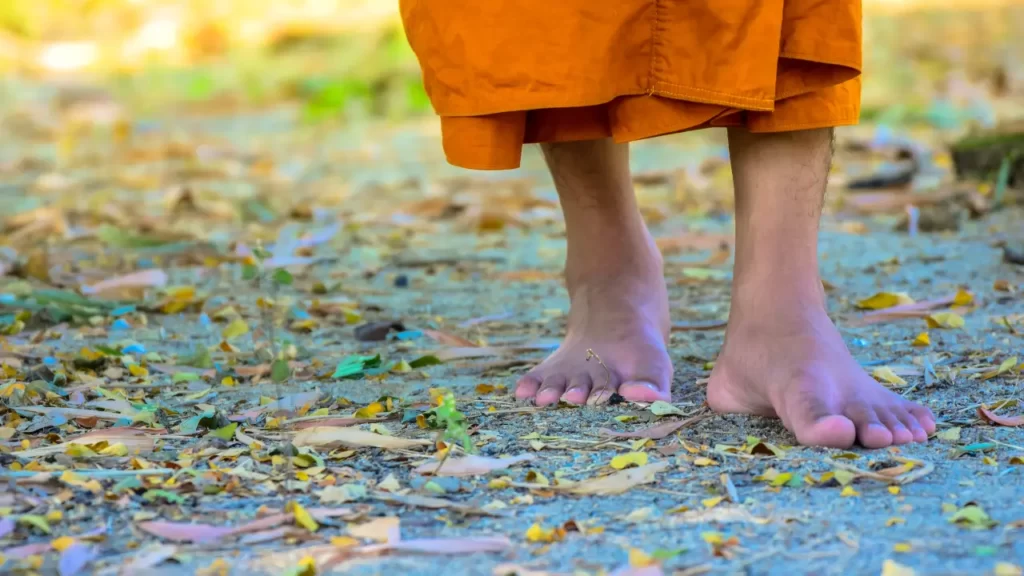Nowadays, amid the complexities and challenges of life, many people face psychological issues. A method chosen by many to repel negative thoughts and heal the soul is walking meditation.
This is a kind of mindful movement, a practice that challenges us to synchronize our consciousness with our physical actions, cultivating a deeply grounded awareness in the present moment. With its positive impacts, walking meditation has become a popular practice not only within the meditation community but also in contemporary life.
In this article, LotusBuddhas will tell you what walking meditation is, the techniques as well as how to practice it in your daily life to enjoy many wonderful benefits from it.
What is Walking Meditation?
Walking meditation is a form of meditation in motion that, unlike traditional seated meditation, involves walking consciously and with focus. It’s a practice rooted in various spiritual traditions but is particularly prominent in Buddhism, where it serves as a way to cultivate mindfulness and presence while moving.
Walking meditation is a form of meditation practice that incorporates mindful movement into the process of meditation. Instead of remaining in a static posture, typically seated, the practitioner engages in mindful walking, focusing on the sensations and experiences of moving through space.
In walking meditation, every step is taken with intentional awareness. The practitioner is fully engaged in the experience of walking, paying close attention to the sensations in their feet, the rhythm of their breath, and the movement of their body. The path doesn’t need to be long or special; it can be as simple as a quiet room or a garden path, as long as it allows for undisturbed, mindful walking.
The goal of walking meditation is to bring the mind into the present, connecting with the body in motion and observing the subtleties of each step. This mindfulness practice helps to calm the mind, reduce stress, and enhance mental clarity. It’s an exercise in being fully present, not just physically but with all senses, creating a harmonious balance between the inner self and the external environment.
Practitioners often use walking meditation as a complement to seated meditation or as a way to integrate mindfulness into daily activity. It can serve as a bridge, connecting meditation practice with the routine movements of life, making the meditative state more accessible in everyday situations.
Techniques of Walking Meditation
This practice involves synchronizing the mind with the body while focusing on the sensations and movements of each step. Various techniques can be employed in walking meditation, which can vary by tradition, teacher, or personal preference. However, some foundational principles underpin most techniques:
- Choose Your Path: Begin by selecting a peaceful, uninterrupted path where you can walk back and forth for 10 to 20 feet. This could be indoors or outdoors, as long as the space feels safe and conducive to focus.
- Start With Intention: Before you start walking, stand still, take a few deep breaths, and set an intention for your practice. This could be anything from developing mindfulness to finding inner peace or simply observing your experiences without judgment.
- Engage Your Senses: As you start to walk, engage all your senses. Notice the feel of the ground beneath your feet, the sounds around you, the temperature of the air, and any smells. Being fully present allows you to connect deeply with the moment.
- Mindful Stepping: Break down each step into smaller parts—lifting your foot, moving it forward, and placing it down. Pay attention to the sensations in each part of your foot and leg as you move. This detailed focus helps anchor you in the present moment.
- Synchronize With Your Breath: Try to coordinate your steps with your breathing. For instance, you might take a step with each inhale and another with each exhale. This synchronization of movement and breath further enhances mindfulness and concentration.
- Walking Slowly: The pace of walking meditation is typically slower than your normal walk. This slowness allows you to observe each movement and sensation more closely, deepening your awareness.
- Return to the Moment: Your mind will inevitably wander. When you notice this, gently guide your attention back to your walking and breathing. This act of returning to the moment is a crucial part of the practice.
- Concluding Your Practice: When you finish your walk, stand still for a moment, and observe the effects of the meditation on your mind and body. Take a few deep breaths, expressing gratitude for the practice and the moment.
These steps represent a basic technique for walking meditation, but there are many variations. For instance, in the Theravada Buddhist tradition, practitioners often use mental noting, silently labeling the movements of each step, such as “lifting,” “moving,” “placing.” Meanwhile, in Zen practice, walking meditation (kinhin) is typically performed in between periods of sitting meditation, and the pace can be faster.
How to Practice Walking Meditation Effectively
To practice walking meditation effectively, you should heed the guidance mentioned in the “Mahāsatipaṭṭhāna Sutta,” where the Buddha speaks of walking meditation and its significance. Proper execution of this practice involves several thoughtful steps to ensure it aligns with the Buddha’s teachings.
Firstly, choose a clear, straight path of at least 3 meters in length—although longer paths are also suitable. Initiating the meditation, gradually shift your focus down to your feet. Practitioners often walk barefoot to enhance tactile sensations and achieve a better sense of balance.
The essence of walking meditation lies in the deliberate shifting of your weight from one foot to the other. Start by lifting your right foot, paying close attention to evenly distributing your body’s weight. As you lift, maintain focus and balance on your left foot, spreading the toes to support your body’s upper part.
Gently place your right foot forward, touching the ground in an orderly fashion—heel first, followed by the sole. Once your right foot is fully grounded, shift your weight forward gradually and start lifting your left heel. The motion of lifting your left foot should mirror the action taken with the right.
Maintain intense focus on your body and feet throughout the practice. You can position your hands behind your back or let them hang loosely at your sides—choose whichever helps maintain peak concentration. If distractions arise, integrate simple mantras or short verses into your practice to recenter your attention on your physical being.
After repeating the lifting and placing steps until you reach the end of your path, stop, stand erect, and breathe evenly. Then, turn around, regain your composure, and repeat the process back to the starting point. At the journey’s end, do not halt abruptly; rather, reflect inwardly, acknowledge any released burdens, and cultivate positive energy.
The crux of walking meditation is maintaining focus to connect each step with your breath. The duration of a session can vary from 10 to 40 minutes, depending on individual pace and path length, ensuring a personalized and meaningful practice.
Benefits of Walking Meditation for The Mind and Body
Walking meditation, a mindfulness practice that combines the physical act of walking with the mental discipline of meditation, offers a range of benefits for both the mind and the body. These benefits have been substantiated by both traditional wisdom and modern scientific research. The practice not only cultivates mental clarity, focus, and emotional balance but also promotes physical health and well-being.
From a psychological perspective, the practice of walking meditation fosters a range of mental and emotional benefits. These include:
- Improved focus and concentration: By directing attention towards the act of walking – a task often performed automatically – walking meditation develops skills of concentration and mindfulness. This increased ability to focus can extend to other areas of life, improving work performance, studying, and other tasks that require sustained attention.
- Reduced stress and anxiety: Regular practice of walking meditation can decrease symptoms of stress and anxiety. As the practitioner learns to focus their mind and body in the present moment, they develop skills to manage stressors more effectively. Mindfulness-based practices have been shown to down-regulate the stress response, fostering a sense of calm and relaxation.
- Emotional balance: Walking meditation supports emotional regulation by allowing practitioners to observe their emotions without getting entangled in them. This helps cultivate emotional resilience and balance, reducing reactivity to emotional triggers and promoting greater self-understanding and empathy.
- Enhanced creativity: Some practitioners and researchers suggest that walking meditation can stimulate creativity. The rhythmic, mindful movement can help clear the mind, potentially sparking new ideas and insights.
From a physiological perspective, walking meditation provides a host of benefits. While being a low-impact physical activity, it still encourages movement and aerobic activity, leading to:
- Improved cardiovascular health: Regular walking helps improve cardiovascular fitness, reducing the risk of heart disease. It helps lower blood pressure, improve cholesterol levels, and enhance overall heart health.
- Increased energy levels: Engaging in physical activity, even gentle movement like mindful walking, can boost energy levels. The increased blood circulation and oxygenation resulting from walking can leave practitioners feeling more energized and alert.
- Improved digestion: Regular walking can stimulate the digestive system, enhancing metabolism and helping with digestion. The physical movement aids in moving food through the system more efficiently.
- Better sleep: Physical activity, such as walking, is known to promote better sleep. Moreover, the stress-reducing benefits of mindfulness can also improve sleep quality by reducing insomnia symptoms.
- Enhanced immune function: Regular physical activity, such as walking, can boost the immune system’s function. Additionally, stress reduction from mindfulness practices may support immune health by reducing the detrimental impact of stress on the immune response.
Walking meditation can contribute significantly to both mental and physical health. It represents a holistic approach to well-being that recognizes the interconnections between the mind and the body, helping to cultivate a state of balanced health and mindful presence in every aspect of life.
Some Common Misconceptions about Walking Meditation
Despite the growth in popularity and acceptance of mindfulness practices, including walking meditation, several misconceptions persist. These misunderstandings can mislead prospective practitioners, distort expectations, and potentially deter individuals from pursuing or continuing the practice.
- Walking meditation is less effective than sitting meditation: Some individuals believe that walking meditation is a “lesser” form of practice compared to sitting meditation. However, walking meditation is not inferior; it’s simply different. It offers unique benefits, such as the integration of movement and mindfulness, which can be particularly useful for individuals who find sitting meditation challenging or uncomfortable.
- Walking meditation is only for monks or spiritual seekers: While walking meditation has deep roots in various spiritual traditions, including Buddhism, it is not exclusive to these groups. Anyone can practice walking meditation, and its benefits extend across all spheres of life, including improved physical health, mental clarity, stress reduction, and increased focus.
- Walking meditation must be slow: While many forms of walking meditation advocate for slow, deliberate movement to enhance mindfulness, this is not a fixed rule. The pace can be adapted to fit the practitioner’s comfort and circumstances. Some traditions, such as Zen Buddhism, even practice faster forms of walking meditation.
- Walking meditation requires a natural setting: While practicing walking meditation in a natural setting can be pleasurable and beneficial, it is not a necessity. Walking meditation can be done in a variety of settings, including urban areas, indoors, or even in a hallway. The key is the practitioner’s internal state of mindfulness, not the external environment.
- Walking meditation is a form of exercise: While walking meditation does involve physical activity, its primary aim is not to improve physical fitness. The focus is on cultivating mindfulness and awareness through the act of walking. However, walking meditation does offer some physical health benefits, such as improved circulation and stress reduction.
- One must always feel calm and focused during walking meditation: Although one of the goals of walking meditation is to foster a state of calm and focus, it is normal for the mind to wander or for practitioners to experience restlessness, distraction, or difficult emotions during the practice. Rather than viewing these experiences as failures, they are opportunities to observe the mind’s habits and cultivate mindfulness in the face of distraction.
LotusBuddhas hopes that through understanding these misconceptions, you can better understand the true nature and benefits of walking meditation. It is a versatile, accessible, and effective practice that can complement other forms of meditation and mindfulness practices, making a significant contribution to one’s physical and mental well-being.










